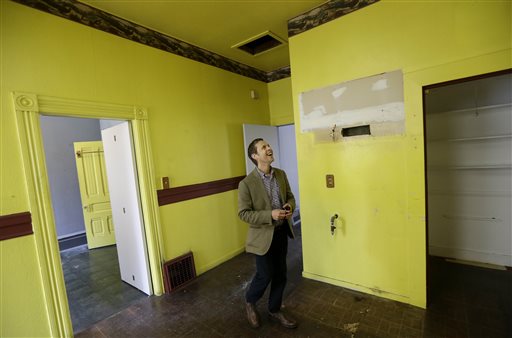
George Limperis, a realtor with Paragon Real Estate Group, smiles as he walks through the kitchen of a property that was recently sold in the Noe Valley neighborhood in San Francisco, Wednesday, July 30, 2014. (AP Photo/Jeff Chiu)
SAN FRANCISCO — San Francisco Association of Realtors President Betty Taisch has two words of advice for those who want to live in the city and think $1 million will buy them their dream house: Think again.
In the world of San Francisco real estate, where the median selling price for houses and condominiums last month hit seven figures for the first time, the $1 million that would fetch a mansion on a few acres (hectares) elsewhere will now barely cover the cost of an 800-square foot (243-square-meter) home that needs work and may not include private parking.
The technology’s industry’s rapid growth, coupled with San Francisco’s constrained supply of housing, is a big part of the story behind the city’s ascension to a rarified real estate bracket already occupied by New York.
But Silicon Valley wealth is also stoking the market in the greater San Francisco Bay Area, according to Andrew LePage, an analyst with CoreLogic DataQuick, a California real estate research firm.
Between April and June, the Bay Area saw a record number of homes and condos going for $1 million and above, and they accounted for one-quarter of all sales in the region, CoreLogic DataQuick said Thursday.
During the same three-month period, six of the Bay Area’s nine counties set records for the number of homes and condos selling for over $2 million, as did California as a whole, the report said.
George Limperis, an agent with Paragon Real Estate Group in San Francisco, agrees that freshly minted technology millionaires who can afford to bid up a property until they win it with an all-cash offer are helping to drive up demand.
But unlike during the city’s first tech boom in the late 1990s, the buyers prepared to lay down more than $1 million on a fixer-upper in a neighborhood within walking distance of shops and restaurants also include Asian investors and retirees from major cities worldwide who already are accustomed to skyscraper prices for shoebox dwellings, Limperis said.